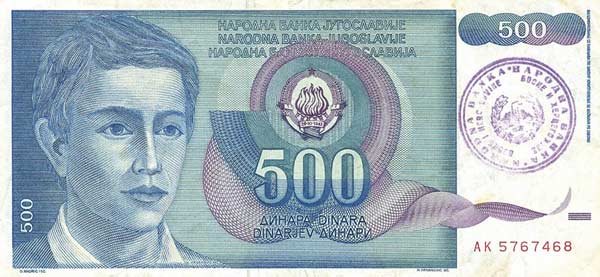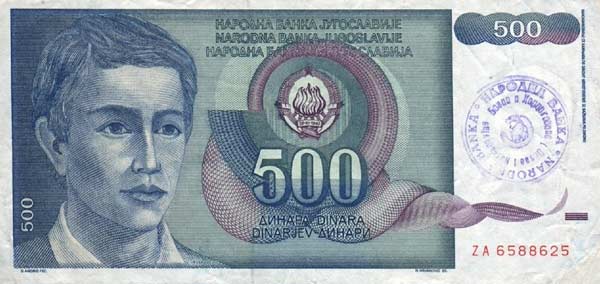On Bosnia and Herzegovina P-1 and P-2 notes

The Republic of Bosnia and Herzegovina proclaimed its independence from the former Socialist Federal Republic of Yugoslavia in March of 1992 and gained international recognition in April of the same year, simultaneous with the breakout of the Bosnian war. During the war plenty of banknotes were issued -- some by the recognized government of the Republic, by some regional authorities, and some by the self-proclaimed “Serb Republic of Bosnia and Herzegovina”. Besides these notes, today one can find, both in the Standard Catalog of Paper Money and also on the numismatic market, some banknotes whose authenticity was never confirmed (e.g. P-53, P-54, P-55), and a lot of notes that are counterfeits, mostly being produced several years later specifically to defraud paper money collectors. These counterfeit and fake notes have flooded the numismatic market. Unfortunately, to this day they are offered and sold even by sellers with high seller reputation.
Two such “potentially problematic” notes are the Bosnia and Herzegovina P-1 and P-2 notes. These first banknotes of Bosnia and Herzegovina are the overprinted Yugoslavian notes P-106 (500 dinar) and P-107 (1000 dinar) from the 1st of March, 1990. They are emergency issues that were circulated between May and August 1992, and only in the area of the state capital Sarajevo under siege by Serb forces. The National Bank of Yugoslavia (NBY) had stopped the supply in May 1992 to the National Bank of Bosnia and Herzegovina (NBBH) with the notes P-108, P-109, P-110 and P-111 (100, 500, 1000 and 5000) of the Yugoslavian dinar (YUN). That caused a shortage of banknotes in circulation, as the introduction of the own Bosnian-Herzegovinian currency was scheduled on the 1st of July, 1992.


Figures 1 and 2
The banknotes P-106 and P-107 were available in the treasury of the NBBH, since there was previously an exchange of these banknotes in circulation in December 1991, when the notes P-105, P-106 and P-107 had been withdrawn and replaced after the declaration of independence by Slovenia and Croatia, two other former Yugoslavian republics. The NBBH decided to use the notes at stand, manually stamping them with one of the six official round seals of the NBBH. Only notes that were previously in circulation have been sealed, therefore there cannot be any note P-1 or P-2 in uncirculated condition.

Among the seals that were used are three smaller overprints (30mm in diameter) for the 500 dinar note, and three bigger overprints (48mm in diameter) for the 1000 dinar note. All of them have the name of the bank inscribed in Latin lettering at left, and Cyrillic lettering at right, with the coat of arms of the Republic centered on the seal (valid until 4th of May, 1992 but then not yet replaced), with numbers 1 or 2 or without them. Any other seal inscription is a clear sign of a fraud attempt – even those by Tuzla Agency for public accounting (Figure 3). NBBH was to perform stamping in the Tuzla area, but did not do so at that time.

Figure 3
The notes P-1 and P-2 were circulated until the 25th of August, 1992 and have been replaced by Bosnian-Herzegovinian dinar notes (P-10, P-11, P-12, P-13, P-14, P-15) and Sarajevo coupon issue (P-21 to P-27 for Sarajevo under siege). Today, the eBay search “Bosnia p1” or “Bosnia p2” would offer plenty of notes – which contradicts the very short time and small area where they had circulated. Most of those notes would look like the one in Figure 4.

Figure 4
Unfortunately, these notes have mostly the fake seals. The fake stamp for P-2 is easy to spot since the producers had made a grammatical error in the name of the bank in the Latin script. It says “NARODNA BANKA BOSNA I HERCEGOVINE”, which is a false genitive case of the word “Bosnia” – it should be “BOSNE”. This error occurs only on P-2b (number 1 on the seal). Also, the outer rings of the seal have unusually large white space between them, compared to the real seals (see Figure 2). All three real stamps for P-2 have the same form.
The same error is not to be found on the fake P-1 note, but we should observe the dominant one on the market: P-1b. In comparison to the other seals (see Figures P-1 and P-1b), their print is always very clear and precise, what is not the case with hand stamps. Figure 1b shows what P-1b should look like, P-1c is almost the same, while P-1 is different, shown on Figure 1a. My assumption is that here we have another argument for a forgery: the snowflakes on the seal. Below the coat of arms there is a number 1 and a small snowflake. They should be aligned with the vertical axis of the coat of arms. That is not the case here, but is with all the other 5 seals used, as well as with other official Bosnian stamps.
Article Sources:
[1] Sulejmanagić, Amer: Monetary Situation in Bosnia and Herzegovina since 1992 until the Introduction of Convertible Marka, Dinar, Nr.22, Serbian Numismatic Society Belgrade, 2007
[2] VišÄević, Zlatko: Coins and Banknotes of Yugoslavia, Slovenia, Croatia, Bosnia and Herzegovina, Serbia, Montenegro and Macedonia, Second Issue, Numismatic Society “Castua”, Rijeka, 2011





